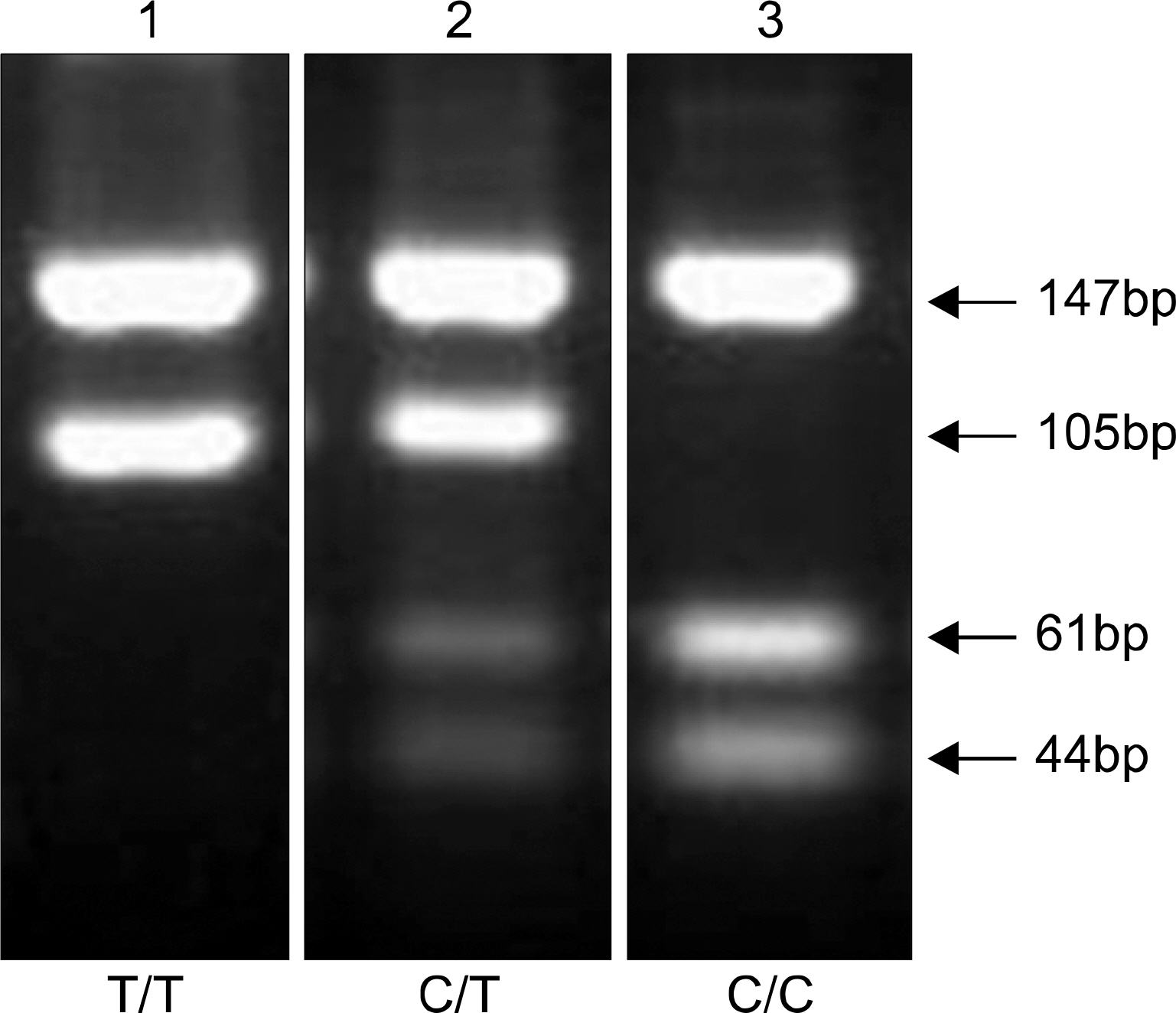Korean J Urol.
2008 Jan;49(1):55-59.
Eta-1/Osteopontin Genetic Polymorphism is Associated with Urolithiasis in Koreans
- Affiliations
-
- 1Department of Urology, College of Medicine, Chung-Ang University, Seoul, Korea. uromyung@yahoo.co.kr
- 2Department of Laboratory Medicine, College of Medicine, Chung-Ang University, Seoul, Korea.
Abstract
-
PURPOSE: Osteopontin(OPN) is one of the major non-collagenous bone matrix proteins produced by osteoblasts and osteolclasts, and it is also involved in the pathogenesis of urolithiasis. Single nucleotide polymorphisms(SNPs), as a tool for searching for the genetic markers of disease, have a large role in investigating the genetic markers of complex human diseases. The aim of this study is to investigate the association with this SNP at position nucleotide 9250(C-->T) in the OPN gene and the susceptibility to urolithiasis. We also compared the allele frequency of Koreans with those of Americans and Japanese.
MATERIALS AND METHODS
A total of 161 urolithiasis patients and 104 healthy controls were studied. The SNPs located at position 9520 in the OPN gene were genotyped using restriction fragment length polymorphism(RFLP). The wild-type sequence contains a C while the polymorphism variant is a T(C-->T), which results in the appearance of an Alu I restriction site.
RESULTS
The gene frequencies of C/C, C/T and T/T at position 9250 on the Eta-1/osteopontin gene in urolithiasis patients were 10.6%, 36.6% and 52.8%, respectively, compared with 6.7%, 27.9% and 65.8%, respectively, in the controls(p>0.05). The allele frequencies of C and T at this position in the urolithiasis patients were 28.9 and 72.1, respectively, whereas those in the controls were 20.7 and 79.3, respectively,(p<0.05). The allele frequencies found in the present study were compared with those coding SNPs described in the USA database; 60 and 39(USA) vs 20.7 and 79.3 (Korea), respectively(p<0.05).
CONCLUSIONS
Those findings suggest there is no association of with Eta-1/osteopontin genetic polymorphism, but the allele frequencies were significantly associated with urolithiasis patients. We also observed difference of allele frequencies in our controls and in the USA controls and these differences may be caused by a difference in the incidence of urolithiasis patients between the two countries.
Keyword
MeSH Terms
Figure
Reference
-
References
1. Leusmann DB, Blaschke R, Schmandt W. Results of 5,035 stone analysis: a contribution to epidemiology of urinary stone disease. Scand J Urol Nephrol. 1990; 24:205–10.2. Watts RW. Idiopathic urinary stone disease: possible polygenic aetiological factors. QJM. 2005; 98:241–6.
Article3. Xie Y, Sakatsume M, Nishi S, Narita I, Arakawa M, Gejyo F. Expression, roles, receptors, and regulation of osteopontin in the kidney. Kidney Int. 2001; 60:1645–57.
Article4. Forton AC, Petri MA, Goldman D, Sullivan KE. An osteopontin (SPP1) polymorphism is associated with systemic lupus erythematosus. Hum Mutat. 2002; 19:459.
Article5. Gao B, Yasui T, Okada A, Tozawa K, Hayashi Y, Kohri K. A polymorphism of the osteopontin gene is related to urinary calcium stones. J Urol. 2005; 174:1472–6.
Article6. Lopez CA, Hoyer JR, Wilson PD, Waterhouse P, Denhardt DT. Heterogeneity of osteopontin expression among nephrons in mouse kidneys and enhanced expression in sclerotic glomeruli. Lab Invest. 1993; 69:355–63.7. Noiri E, Dickman K, Miller F, Romanov G, Romanov VI, Shaw R, et al. Reduced tolerance to acute renal ischemia in mice with a targeted disruption of the osteopontin gene. Kidney Int. 1999; 56:74–82.
Article8. Asplin JR, Arsenault D, Parks JH, Coe FL, Hoyer JR. Contribution of human uropontin to inhibition of calcium oxalate crystallization. Kidney Int. 1998; 53:194–9.
Article9. Lieske JC, Leonard R, Toback FG. Adhesion of calcium oxalate monohydrate crystals to renal epithelial cells is inhibited by specific anions. Am J Physiol. 1995; 268:F604–12.
Article10. Worcester EM, Beshensky AM. Osteopontin inhibits nucleation of calcium oxalate crystals. Ann NY Acad Sci. 1995; 760:375–7.
Article11. Wesson JA, Worcester EM, Wiessner JH, Mandel NS, Kleinman JG. Control of calcium oxalate crystal structure and cell adherence by urinary macromolecules. Kidney Int. 1998; 53:952–7.
Article12. Yamate T, Kohri K, Umekawa T, Amasaki N, Amasaki N, Isikawa Y, et al. The effect of osteopontin on the adhesion of calcium oxalate crystals to Madin-Darby canine kidney cells. Eur Urol. 1996; 30:388–93.13. de Water R, Boeve ER, van Miert PP, Vermaire CP, van Run PR, Cao LC, et al. Pathological and immunocytochemical changes in chronic calcium oxalate nephrolithiasis in the rat. Scanning Microsc. 1996; 10:577–87.14. de Water R, Leenen PJ, Noordermeer C, Nigg AL, Houts-muller AB, Kok DJ, et al. Cytokine production induced by binding and processing of calcium oxalate crystals in cultured macrophages. Am J Kidney Dis. 2001; 38:331–8.
Article15. Kim H, Jo MK, Kwak C, Park SK, Yoo KY, Kang D, et al. Prevalence and epidemiologic characteristics of urolithiasis in Seoul, Korea. Urology. 2002; 59:517–21.
Article16. Curhan GC, Rimm EB, Willett WC, Stampfer MJ. Regional variation in nephrolithiasis incidence and prevalence among United States men. J Urol. 1994; 151:838–41.
Article17. Iwasaki H, Shinohara Y, Ezura Y, Ishida R, Kodaira M, Kajita M, et al. Thirteen single-nucleotide polymorphisms in the human osteopontin gene identified by sequencing of the entire gene in Japanese individuals. J Hum Genet. 2001; 46:544–6.
Article18. Scheinman SJ. Nephrolithiasis. Semin Nephrol. 1999; 19:381–8.
- Full Text Links
- Actions
-
Cited
- CITED
-
- Close
- Share
- Similar articles
-
- Osteopontin Genetic Polymorphism and Serum Levels in Patients with Systemic Lupus Erythematosus
- Expression of Eta-1 in Escherichia coli and Production of Monoclonal Antibody
- Vitamin D Receptor Gene BsaM I Polymorphism as Genetic Marker in Patients with Calcium Stone
- Interleukin-1beta, Calcium-Sensing Receptor, and Urokinase Gene Polymorphisms in Korean Patients with Urolithiasis
- Angiotensin-converting enzyme gene polymorphism is not associated with myocardial infarction in Koreans


